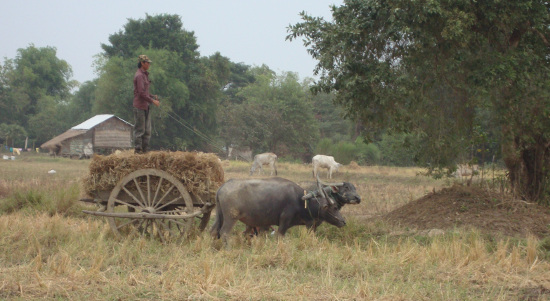
Photo: Sharon May, “Rice Harvest, Battambang, Cambodia” (2010)
During the Japanese occupation of Cambodia from 1942 to ’45, there were no garments for sale. The French army, civil servants, and businessmen had all been captured by the Japanese army. All the French had disappeared—to where, I had no idea. The poor people in my village used sugar-palm leaves to make skirts and vests. My eldest brother, U Sa Em, was studying in Phnom Penh at the time and found a semi-automatic loom to weave cloth. He knew how to weave cloth, and taught my older sister, U Sa Mouth. My father, U Un, my brother, and my uncle Hem Tim built a semi-automatic loom at our house on the bank of the Vaiko River, in the village of Thlok.
My mother was a successful raiser of silkworms. Silkworms could smell when a woman was having her period; consequently, any menstruating woman was forbidden from getting close to my house because (it was believed) the silkworms would die instantly. My mother was always clean, meticulously clean.
My father traveled around far from home to buy mulberry leaves to feed the silkworms my mother raised. Sometimes, during the monsoon season, he had to row his canoe across the Vaiko River to my Uncle Tim’s district. He was pelted intermittently by heavy rains. In such conditions it’s hard to row a canoe built of a sugar palm tree.
When my father worked in the paddy fields, he raked the mud after five other men had plowed the fields. There were many women who worked for him; they received sixty-five pounds of rice for three days work. Sometimes seven women, sometimes nine. Two water buffalo pulled the rake. The rake was two-and-a-half yards wide. With a bamboo hook in his right hand, my father would grab the cords attached to the two buffalos to steer them. He stood on the rake behind the buffalo and sang, teasing my mother. People laughed so hard they were in tears; some women laughed so hard that they actually peed in the mud where they worked. Of course, the women in my village never wore panties; actually, at that time, none of them had ever seen panties in their entire lifetime. I have a distinct memory of the sound pee makes when it spills down on water.
When silkworms were ripe, my mother put them in a bunch of smach plants (spicy plants that grow as high as one’s hip) in which the silkworms built their cocoons. How long this part of the process took, I can’t remember. But after the silkworms became duckdoeurs we put the cocoons in boiling water and drew the silk from the cocoons. On the first draw the threads were thick and rough. These threads were often used to weave boys’ shorts. We didn’t wear vests at that age. The thin threads were used to make shiny silk cloth for my sisters and mother. My father also grew cotton; my mother used those fibers to weave cloth for boys clothing. Since we didn’t have soap, lice abounded in our shorts, so we wore them loose-fitting.
My mother used the core of the jackfruit tree, and tbeng, and mcloeur fruits to dye the silk to get colors she wanted: red, purple, green, black, etc. . . . One day I boiled three pieces of jackfruit core with a tbeng core and the color came out violet. From then on my mother used my formula.
© U Sam Oeur. By arrangement with the author. Translation © 2015 by Ken McCullough. All rights reserved.








